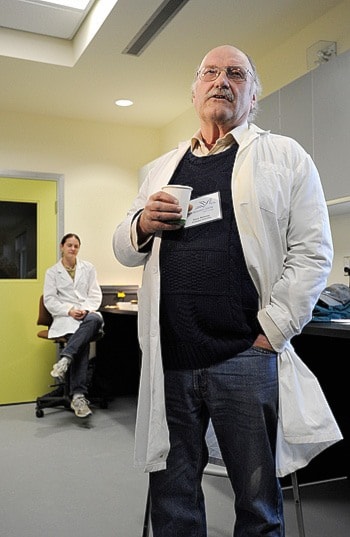It’s still almost empty but if you know what you’re looking at, the Yukon Research Centre’s new lab is something special.
“This has been a dream a long time coming,” said Dave Mossop, an ornithologist and professor emeritus with Yukon College.
Mossop, who has been researching Yukon biodiversity for years, is happy to see the lab built.
Traditionally people Outside have conducted most of the research done in the Yukon, he said.
“My vision has long been to get our undergraduate students involved in research projects,” he said. ” There’s nothing like getting to know things firsthand.
“Very few people spend time looking down a ground squirrel hole.”
Though it only opened yesterday, Mossop’s hopes are already being realized.
His student, Katrina Wohlfarth, is already using the lab for research.
Wohlfarth is studying the eating habits of boreal owls, about which very little is known.
Her work involves collecting owl castings - owl puke - picking through the bones and fur to identify the small mammals they’re eating.
“It’s exciting to have the space to do this kind of work,” said Wohlfarth. “Otherwise, I don’t think I’d be doing it.”
She plans to publish a paper on the subject, which she hopes will give her credit towards a master’s in biology.
Wohlfarth, who grew up in Haines Junction, is a typical Yukon College student, said Mossop.
She started her undergrad at the college, moved south to the University of BC to get her biology degree. Now she’s back taking a few classes at the college.
With this new facility, she might not have to leave to do her master’s.
“It opens up the opportunity to do the majority of my research here in the Yukon,” said Wohlfarth.
In the recent territorial election, the Yukon Party floated the idea of turning Yukon College into a full-fledged university.
Though that’s a long way off, this new lab gets the college one step closer, said Clint Sawicki, director of research services for the Yukon Research Centre.
The facility took two years to build and cost $2.7 million.
It was paid for by the federal stimulus money from the Economic Action Plan and the Arctic Research Infrastructure Fund.
Now that they have the lab, they must fill it with equipment.
Right now, the only thing in the lab - other then Wohlfarth picking through owl puke - is a $37,000 fume hood, a glassed-in workspace to process samples.
Equipment will cost about $700,000, said Sawicki.
Just what kind of equipment the lab will get depends on what projects get approval, he said.
They have several grant applications pending for research into things like climate change, mining life cycles and north-specific parasites.
Having facilities like this opens up a lot of doors, said Sawicki.
“It makes us eligible for grants from a lot of the national funding agencies,” he said.
The lab is a class 2 biohazard facility that can accommodate up to four research projects.
There is a clean room to prevent contamination and the facility includes lots of secure storage that can keep samples frozen, cold or at room temperature.
Upstairs there’s boardroom for presentations and conferences.
In addition, there is a large empty room on the first floor that, it’s hoped, will eventually be turn into a natural history museum.
The facility is a work in progress.
“We’ve got proposals in the hopper for more space,” said Sawicki. “We all believe that this will grow.
“We’re building these pieces to actually become a university.”
Contact Josh Kerr at
joshk@yukon-news.com
